CarMD
Company: CarMD
Price: $98.99
http://www.carmd.com/
The CarMD diagnostic tool is a "Do It Yourself" (and sadly, "As Seen on TV") device that connects to your vehicle’s On Board Diagnostic Port (OBD2) and lets you understand what is going on under the hood. Unlike some devices that read and display data from the OBD2 connector real-time (like real time gauges), this device has one function, and one function only: To help you understand what, if anything, is wrong with your car using this device and your computer, and it supports Mac and PC alike.
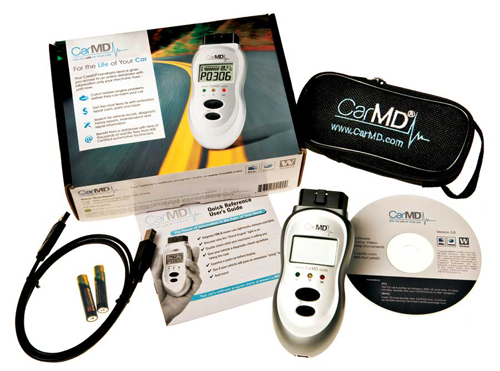
The device is fairly easy to use, but I suggest reading the small instruction booklet before you start. I didn’t (who reads instructions these days?), and I ended up entering some bogus info into the CarMD database for my car, which I could not remove.
To get started, one would think you should start by installing the software that comes with the unit. You would think, but this is not the case. Of course, not reading the instructions, as I said, I did what most people would do after opening the box, inserting the batteries, and playing with the hardware for a few minutes, I started by installing the software onto my Mac. I then created my account on the CarMD web site as it instructed, it then asked me to connect the device to "marry it" to my account, and BAM, the data already inside the device, which was NOT for my car, was immediately transferred to my account and counted as the first of the limited 6 monthly reports one is allowed. It was also telling me that my car had unusual problems, which the hybrid car I own could not have. Obviously, some test data was still in the device and got downloaded to my account.
OK, not knowing how this incorrect data might be used in reference to my car in the future (can CarFax see this?) and since you are limited to just six reports a month, I decided to email customer support to get this removed. I am sorry to say, customer service was not good! After a number of email exchanges where it was obvious either the person had language problems, or I was simply asking for something that their email scripts did not allow for, and after them offering me a number of solutions that had nothing to do with my request, they finally told me basically, "too bad, we will not remove it." OK, we ALL know that people never read instructions, installing software is typically the first step, so I am sure this was not a unique problem, and yet they have no a procedure to correct an incorrect recording when it occurs. Oh well… it was time to try it out correctly ( and this time I will read the instructions. )
I was supposed to start by installing the batteries and pressing the small button on the device’s front to turn it on. The LEDs will flash, the display SHOULD show a 0 (although not an issue if it shows something else), and the green LED will light. It is ready. NOW, before installing the CD software, take the unit out to you car, connect it to the OBD2 connector, record the car’s diagnostic data, and THEN bring it back to your computer to register.
OK, lets start again. Since i was already powered up and ready to go, I connected the device the my car. If you know where your OBD2 connector is, your ready to go. If not, CarMD has a guide on their web site to display the connector location for your car, looking up my make, model, and year.
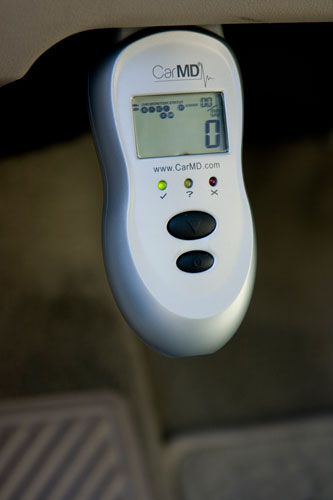
I plugged the CarMD unit into the OBD2 connector of my Prius, turned on the ignition, and waited a few seconds. The CarMD read the status of my vehicle’s on-board diagnostic system, beeped to indicate it was done, and then one of three LEDs lit up. On my Prius, the light was green and the display read zero. I repeated a second test on my wife’s VW Turbo Beetle, was it was also green and displayed zero.
These LEDs tell you something right away. If green lights, your vehicle is OK and the device didn’t detect any stored diagnostic codes in your car. CarMD also claims from this data that your vehicle should pass an emissions test. Not an issue for my Prius, it is exempt from emission tests, but good news on my wife’s VW!
If yellow lights up, it means one of two things. Either it indicates your diagnostic system was recently reset and the internal monitors have not completed their tests, or there is a problem pending in your car, but not yet serious enough to turn on the check engine light.
If red lights up, your check engine light is probably also lit, and there are problem codes stored in your car. The LCD display will show "FAIL" and any of the stored codes can be viewed on the device by pressing the large button to scroll through the codes.
The LCD shows the diagnostic codes found, if any, the total number of error codes found (in the upper right of the display), and it may also display a series of icons in the upper left that indicate emission control problems. But what do these all mean? The booklet that comes with the device does not list any of these codes or icons, and while I can find some of them on the web, it would still take me hours to figure out what it all meant. But fear not, this is where CarMD really shines.
BUT, when using this device, it is really not very useful unless your Check Engine Light is actually on, as that indicates a problem with the car. Well, given that our two cars showed green, meaning no problems, I need to find a car with problems to really check this out. Since you are allowed to register up to three cars with one device (a limitation in my view) I needed to find another car with a problem.
Lucky for me, along came my friend Andy in his 2001 Mercedes SLK, and his check-engine light WAS on! Perfect. We looked up his connector location (hidden behind a small panel) and plugged in the device, and turned on the key. A few second later, it beeped and immediately turned on the red LED. The LCD display showed 3 error codes, P0455, PO300 and P0303 and some of those little icons along the top left of the display were also blinking.
So now that I have some real data in the device, its was back to my computer to find out what it all means. I connected the device to my Mac with the provided USB cable. The software was already installed, but this would have been the time to install it if I had not. The installer adds a small software application that acts as a conduit which connects your device to the CardMD website. The software must be running, and is installed to launch at start-up. When you connect the CarMD device, the small application should open a browser window to CarMD diagnostic website, although a few time I had to bring it to the front to get it to activate, this typically works. The first time you connect you will create an account and register/pair your device. After that, future connections will promote you to login to your account.
The CarMD device will then upload all its data to the website, including your car’s vehicle identification number (VIN), which will be used on later scans to make sure the data goes to the right car. Once the data is transferred, you will be presented with a basic summary and the ability to run a full report. You get to do 6 full reports a month, and only "red light" reports count against this limit, but then again, if you got a green light, why would you need a report?
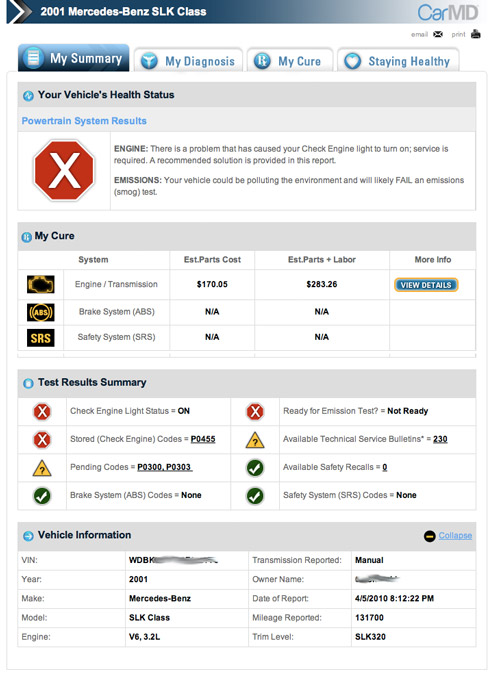
If there were problems, as in the case of the Mercedes, running a report will present you a summary report, as well as a cost estimate to repair. CarMD has a very large database of problem codes cross-referenced to a large number of repair shops, data they have been collecting for over 10 years now, and gives a fairly accurate summary of the costs to repair. This can be quite valuable if you take the car in for repair, as you will know if the estimate given is reasonable or not. The site also gives you a breakdown of parts needs as well by pressing the View Details, or going to the "My Cure" tab in the report.
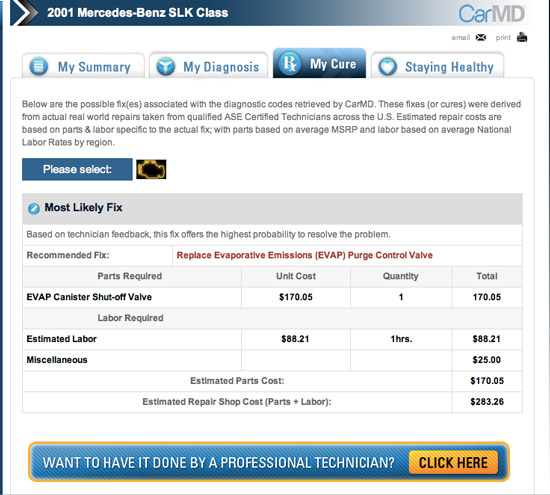
In the MyCure view, you will see a parts cost, and an estimate of the labor based your car, your zip code and the diagnostic codes reported. Keep in mind that this is just an guess based on the codes and their experience, but that large database means it has a good chance of being correct.
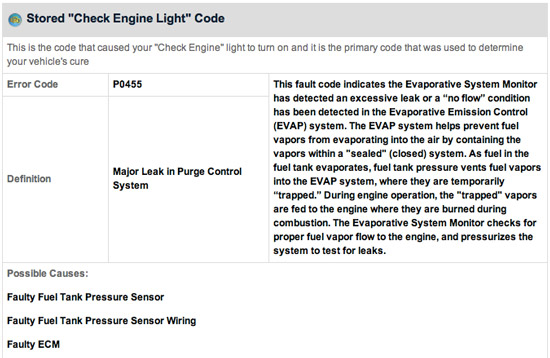
On the MyDiagnosis tab, you will see detailed explanation of each of your problem codes, and suggestions as to what may have caused that code to fire. For example, in the picture above, the unit reported there was a "Major Leak in Purge Control System", and a detailed explanation of what that means, and some possible causes of that error.
Conclusion
So what does this all mean? With all this information at hand, you may find some problems that can be fixed yourself. For example, a bad gas cap can cause the Check Engine light to turn on, and this device will tell you to check for that. A $5 gas cap, or maybe one that is just loose, is a lot cheaper than a $125hour service call to discover the same thing. And it will make taking it to the shop a lot easier as well, and will even print a full report for you to take with you. This could save you hundreds of dollars in unnecessary repair costs.
Many problems, when solved, will cause the check engine light to go off after a short time, however, some may not, and this device will not turn it off for you. In fact, it will not send any codes into your car at all, and will not make adjustments to any car features. If that is what you are looking for, consider something like ScanGuage II, or other OBD device that can alter you car’s functions.
And even though you can only register 3 cars, you can still plug the device into any car you like and see what codes appear. If you are shopping for a used car, for example, carry this with you and check them out. If you really want the car, and you get a red light and a few codes, might be worth registering that car and printing a report. Imagine knowing what it would cost to fix the car before you buy it. Or imagine seeing dozens of codes appear and deciding to pass because of the unseen problems (and maybe even a removed check engine light?)
What I like
This is a simple to use device that will help you know what is wrong with your car. While $99 might seem a bit expensive, the information it provides could easily save you more than that with the first problem it finds. And if buying a used car, this could be invaluable to keep you from buying a lemon.
And if your not near a computer, you can also call a toll free number, give them your account info, and get a diagnostic report over the phone.
And even though I screwed up and did not read the directions, this is an easy to use device. If you follow the instructions, it will be up and running in just a few minutes, and a few minutes later, you will know whats wrong with your car. It was designed to be easy, and it is.
What I do not like
I was initially bothered that one only gets 6 reports a month, and can only register 3 cars, but I guess they have to set some limits somewhere, otherwise you could just pass it around to all your friends and they would sell very few. So for personal use, you can check your 3 cars each twice a month, and frankly, that seem like more than enough for most uses.
Like I said above, I found their customer service to be seriously lacking, but typically, unless the unit breaks, there should be very little reason to call them, so this is not really an issue for most users.
The small application on the Mac has no QUIT menu. To exit the app, you have to right click the dock icon and select Quit. The app has a blank CardMD menu. Small oversight, but novice users may not know how to stop this app from running.
Ok, this is a nit pick, but I also feel they should loose the "As Seen On TV" commercials. This is a well built product that performs well, and is backed by a solid company. But frankly, almost every product I have ever seen from "As Seen On TV" has turned out to be junk, and I think these ads cheapens the "image" of the device. I am not sure I would have taken it seriously f I saw it was advertised there.
Lastly, there are a number of additional things you can do on the website that cost more money. For example. on the Mercedes, I was told that that there were 226 Technical Service Bulletins for the car. The bad news is that they cost you $1.99 each to download and view. While I can understand why they do not just give them all away, for the $99 this device costs, they could have thrown in a few. However, they do offer a $19.95 "Premium Membership" that gives unlimited access to these bulletins, so I guess if you want them, you can get them all for the price of 10. Not a bad deal, but still would have been nice to get a few tossed in.
MyMac Rating: 8 out of 10. It does exactly what it needs to, is simple, and could save you money.
email – MyMac Magazine – Twitter – Advertise – Reviews Archive – Podcast

You got completely phished. It’s an automotive version of “MyCleanPC” where the overpriced OBD-II scanner just prompts you to plug into your computer, where their godlike website purports to tell you what the repairs to your car will cost.
Come on, man: do you think this will tell you about bad CVs? A blown heater core? Electric mirrors that don’t work?
Look code scanners up on NAPA. Thirty bucks, name your brand. None of them will tell amateurs what those codes mean, either, but Google might give them a fighting chance, and really, a good independent mechanic will tell them the same thing.
Sorry sporkmeister, but you are wrong!
Of course this is not going to tell you about bad CVs or a blown heater core, or mirrors that do not work, because those failures do not show up in the OBD codes on the car in the first place. Its not going to tell you if your phone’s battery is low either! It tells you about conditions that cause a “check engine” light to come on. Duh!
However, we have used this on several cars where the Check Engine light did come on, and we were able to get a reasonable readout of what might be wrong, and using their CarMD database, get a reasonably good report of what the repair might be.
When my wife took the car into the first mechanic for an estimate, he tried to bluff her with a bunch of BS and charge us for things that had NOTHING to do with the error codes in the OBD, and we knew what he was saying was just BS, and she did not use him. The next mechanic suggested things that this report also suggested. That alone saved us some money.
On my Toyota, the check engine light came on, I got the codes, and CarMD suggested a bad gas cap. I bought a new one, and the next day, off when the light. That saved me money from not going to the mechanic to see what was wrong. Where are you going to find that on Google?
We also plugged it into a used car a friend of mine was thinking of buying. It reported a number of errors, including some valve timing issues indicating a possibly bad timing belt, a possible bad head gasket (vacuum leak), and two other critical codes. Seems that the check engine light in this car had been disconnected. Without this, we probably would have never noticed it missing in the array of lights that flash when you start the car. Saved him a load of headaches.
As for using Google, again you are wrong. Sure, you can find some info if you do enough searching, but these guys have an amazing database of codes and reported service problems that were found with those codes by a network of repair shops that report codes/repairs. They continue to collect that info, and this is stuff that is NOT in any Google searchable database. Besides, I am not sure what your time is worth, but the few minutes this took me to diagnose and print a reasonable report was MUCH shorter than I suspect anything you might try reading the raw codes and spending hours on Google. Good luck with that.